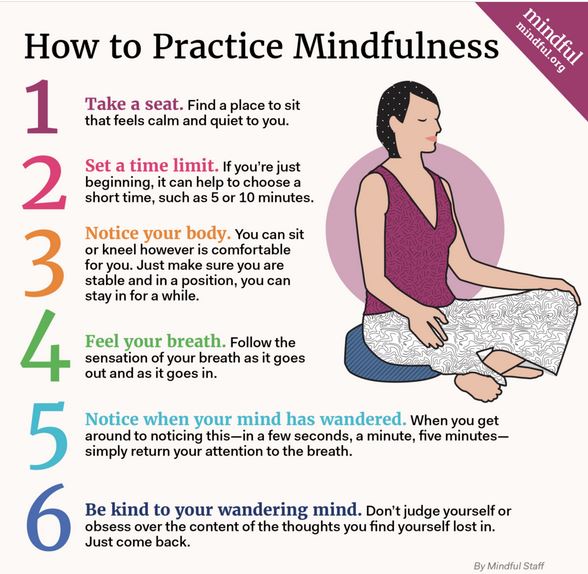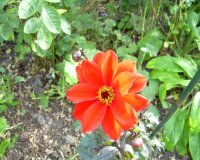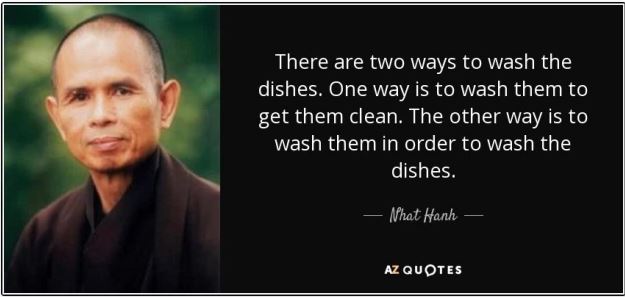How To Practise Mindfulness
Drop The Cushion, Focus Your Mind On NOW
Be Humble And Just Do This Simple Thing
Why learn How To Practise Mindfulness?
Learning how to practise mindfulness is valuable because the practise of mindfulness is a powerful life skill that will reduce your stress and increase your ability to think effectively.
Specifically, it is a practise that enables you:
- To be aware of your body and what it is feeling
- To be fully present and engaged with the tasks and activities you are engaged in.
- To observe the endless repetitive cycles of your thoughts and feelings
- To notice how you become so immersed and totally identified with these thoughts and feelings
- To learn how to stop thinking and enjoy an inner space and peace - whenever you choose to do so
Mindfulness is a natural state. We all have the capacity to be mindful.
The purpose of learning how to practise mindfulness is to develop the skill to do it "on demand" - or to put it technically developing an unconscious competence.
Learning how to practise mindfulness is basically learning a series of
structured mental disciplines and habits that takes your natural and innate ability to be mindful and trains your mind to bring this under your conscious control .
Keeping It Real
Before you read any more on this page, I recommend that you quickly read through these short pieces of about 500 words each as they will provide context and background to the material on this page and the related pages on the theme of "How To Change Your Life".

The Best Way To Learn How To Practise Mindfulness
One of the best ways to get started with mindfulness is not to follow the steps in the illustration above but to take advantage of the many daily opportunities for practising mindfulness in the simple everyday tasks and activities that we normally do on "auto-pilot".
We have already established that mindfulness is a natural state so let's put it into practise with a routine task such as washing the dishes, or putting the trash out and follow these simple steps.
The Problem With Joining A Meditation Group Or Any Formal Practise
Don't get me wrong, of course it's a good idea to take time each day to sit comfortably and focus on your breath and observe your thoughts and emotions as they arise.
But, this is a very secondary activity to actually just doing it!
The sitting on a cushion or joining a practise works better for you as a support and reinforcement rather than as an end itself.
One of the disadvantages of joining a mindfulness meditation group or establishing a daily practice of sitting on a cushion focusing on your breath is that your inner narrative that accompanies these activities becomes:
"...look at me doing mindfulness and being mindful..."
and then there is the social side of joining a group and with it comes a social identity:
"...I am a mindfulness meditator I belong to X practise group..."
What tends to happen is that the practise of mindfulness becomes compartmentalised to the day and time that you go and join with the group or go sit on our cushion.
You become like those people who
put on their best clothes on Sunday and go to church, but for the rest
of the week, their religion makes zero difference to how they live their
life.
Despite its origins in the Buddhist meditation practises of Zazen and Vipasana the practise of mindfulness does not require you to affiliate with any faith tradition or belief system.
Mindfulness practise is actually a very simple and straightforward thing to do.
And here's the rub:
It is because the practise of mindfulness is such a simple, straightforward and natural thing to do, you make it so complicated.
Why?
Because your ego resists:
- Your ego wants to read a book on mindfulness
- Your ego needs to understand mindfulness
- Your ego wants to be informed about mindfulness
- Above all, your ego wants to take on the identity of mindfulness
There is a story in the Bible of a powerful
and successful Syrian military commander called Naaman who contracted
leprosy, and seeking a cure, approached the Jewish prophet Elisha who
was a renowned healer.
Naaman was expecting to be greeted by Elisha and given instructions to
perform a complex ritual, but that didn't happen. Naaman was very
disgruntled when Elisha didn't even come out of his house to greet him
and just sent him a message.
The message was that Naaman would be cured if he simply went down to the
adjacent river Jordan and immersed himself in it seven times.
Naaman's pride was offended, and in disgust he got back in his chariot
and was about to head for home when one of his staff challenged him.
The point was made that had he been asked to, surely Naaman would have
fulfilled any herculean task if that was what it was going to take to
get him cured of leprosy, so why not just do this simple thing and
immerse himself in the Jordan seven times?
But Naaman was still indignant, his pride was
very hurt, and he said that was no way he was going down into the muddy,
dirty water of the river Jordan when there were far cleaner, fresher
rivers at home...
His staff member must have been particularly loyal to Naaman and
concerned for his welfare for he challenged Nathan again along the lines
of why couldn't he just humble himself and just do this one simple
thing if that was all it was going to take to cure his leprosy and save
his life.
The
story concludes with Naaman finally conceding and going down to the
dirt, muddy river and immersing himself in it seven times - whereupon
the miracle happened and he was cured of his leprosy.
This story of the leper and the dirty river is a
powerful metaphor for how to practise mindfulness - be humble and just
do this simple thing - the best and most effective mindfulness
meditation training is to just train yourself to be aware.
There are a wide range of ways of practising mindfulness and I will share some of these mindfulness exercises with you, but the key thing I want you to take on board is to just do it - and keep doing it!
Your mind (and your ego) will resist and you will want to become more
informed about it and will want to read yet another book on mindfulness.
And yet, this is precisely the time for you to apply the simple
mindfulness meditation training of persistent and consistent practise.
The human mind loves to make this simple thing so complicated - yet mindfulness is called a PRACTISE for a good reason!
You mind will get bored and want to be entertained, distracted and
engaged. That's what minds do, and that's why they are sometimes
referred to as "monkey minds".
If you want to learn how to practise mindfulness - if
you are seeking mindfulness meditation training - just be aware - be
present - focus your attention, focus your mind, 100% on whatever it is
that you are doing right NOW - in this present moment.
6 Practices Based On The Work Of Eckhart Tolle Or read this:
Thich Nhat Hanh teaches five simple exercises to help you live with joy.
The Story of the Leper and the Dirty River


If you want some further pointers, you can download:
How To Practise Mindfulness - Key Themes
There are hardware & software reasons why we think the way we do, and these highlight the need for a balanced brain. When we engage with meditation practises, we are re-shaping or re-programming the physical neurological
connections between the left and right lobes of our brains via the
corpus-callosum to achieve the lived experience of a physiologically
better balanced brain!
Being stuck in seeking is the single biggest stumbling block to present moment awareness.It is often the most sincere, the most devout, the most dedicated who are the most stuck in seeking
– in many cases almost as a badge of honour – seeking truth, seeking God, seeking
enlightenment, seeking nirvana, seeking deeper understanding and growth. There is nothing of truth that we can find anywhere but now right here in this present moment.
Mindfulness- as a natural state
Mindfulness is a natural state that occurs spontaneously, when we are unaffected by our thoughts and where we are totally present. The practise of mindfulness is simply a series of structured mental disciplines and habits that take those natural and spontaneous occurrences of present moment awareness and brings them under conscious control and in so doing it makes that freedom more possible, more frequent and eventually available whenever we need it.
Mindfulness meditation technique - the basics
Although it is human nature to venerate and glorify our
great spiritual teachers and put them on a pedestal, we overlook the
fact that the only basic difference between zen-masters and the rest of
us is that they have practised for considerably longer than we have! The operative word here is "practised"!
Practising mindfulness in daily life
There are many daily opportunities for practising mindfulness in the
simple everyday tasks and activities that we normally do on
"auto-pilot". These are excellent further opportunities to learn how to practise mindfulness. Here's what to do...
The
most important exercises are what I call "integration practise",
applying mindfulness into specific situations and states of mind occurring in
daily life. This is where the mindfulness rubber hits the road of real-life...
Mindful listening is active listening. Mindful listening is when you are hearing beyond the spoken words to their essence, and you are not mentally processing and working out what you are going to say next. The dynamics of active listening differ from "normal" listening in several important respects…
Guided Mindfulness Meditation is designed to help you deepen your practise. It is focused on drawing your attention into a mindful practise or to reflections on various insights and teachings.
My experience of mindfulness in a situation of imposed change is illustrated by the story about a king who sought wisdom and summoned the wise man to
counsel him...The wise man said to the king:
"Regardless of whether you are experiencing good fortune or adversity
remind yourself that this too will pass…." I also learned 3 other ways of applying mindfulness to cope with imposed change.
Zen enlightenment - the end of delusion?
Zen Enlightenment – is being free of the effects of the mind. Being stuck in seeking it is the single biggest stumbling block to experiencing it now. There is nothing of truth that we can find anywhere but NOW right here in this present moment.
A zen based process that allows for a shift of perspective on demand and creates the opportunity for a facilitated view of the transcendent. In summary:
- Becoming unstuck and seeing other perspectives
- Recognising and owning disowned voices (or parts of our self)
- Becoming aware of and owning voices/parts of ourself we didn't know existed
- Accessing and owning the "enlightened state"
The key to effective self dialogue is to have tools, techniques and resources that work with all levels of your mind.
This simple self-facilitated technique enables you to do two things:
- To access your unconscious and "hard to reach" parts to enable you to break and change habits and to overcome your inner resistance to personal change.
- To access, experience and communicate directly with your higher or
transcendent self to give you the power to actually follow through and make these changes and have them stick.
Mind Games
Here is how to free yourself from your mind's games. Don't give 100 percent of your attention to the external world and to your mind. Keep some within. 6 practical tips based on my experiences.
Discover the joy of a quiet mind. Cherish the times when you are not thinking about anything. Imagine being able to create a space in your head where there are no thoughts and no emotions... just space and awareness of the sounds and smells and visual images around you...awareness of the sensation of your breath entering and leaving your body. It's not easy. But it is possible. Hear is how.
Further Resources For Students
StudyCorgi provide a range of practical mindfulness resources specifically targeted at students which are simply explained and well illustrated with helpful graphics. There are also links to a range of useful third party articles.
I have no commercial connection whatsover with StudiCorgi and I am featuring their resources simply because I feel this material could be of considerable benefit to students.
These mindfulness resources are free.
8 Mindfulness Practices & 5-Minute Recharging Activities for Students
Return from "How To Practise Mindfulness" to Home Page
LATEST ARTICLES
Dealing With Distraction - Learning How To Live With Your "Attention Autopilot"
 Living With Your Attention Autopilot The good news about your Attention Autopilot is that it will keep you safe. It is continuously scanning your immediate environment for threats. The bad news is tha…
Living With Your Attention Autopilot The good news about your Attention Autopilot is that it will keep you safe. It is continuously scanning your immediate environment for threats. The bad news is tha…The Time Of Your Life - Recognising Moments Of Alignment For Action
 How will you recognise your moment of alignment for action? In this article I want to look at our relationship with time and in the context of the two main themes of this site, firstly as a thinking s…
How will you recognise your moment of alignment for action? In this article I want to look at our relationship with time and in the context of the two main themes of this site, firstly as a thinking s…The Metagame Approach to Second Order Thinking - 5 Guiding Principles
 How To Position Yourself For Survival & Success In A Complex Environment We treat life as though it is a complicated system, and our thinking skills and mental models are focused on understanding its…
How To Position Yourself For Survival & Success In A Complex Environment We treat life as though it is a complicated system, and our thinking skills and mental models are focused on understanding its…Outcome Over Optics - Long Game Outcomes Over Short-Term Ego Gains
 The Day I Learned To Focus On Outcome Over Optics I have never forgotten the day I learned to focus on outcomes over optics and figured out a very simple way of saving myself several hundred thousand…
The Day I Learned To Focus On Outcome Over Optics I have never forgotten the day I learned to focus on outcomes over optics and figured out a very simple way of saving myself several hundred thousand…The ETTO Principle - Why Near Enough Can Be Good Enough
 How To Balance the Efficiency-Thoroughness Trade Off The ETTO Principle describes the inherent trade-off between working efficiently and working thoroughly. This trade-off is something that affects…
How To Balance the Efficiency-Thoroughness Trade Off The ETTO Principle describes the inherent trade-off between working efficiently and working thoroughly. This trade-off is something that affects…Master The Art Of Drawing The Bow
 Focus On Process Not Outcome In so many areas of our lives, we focus on the outcome, not the process that we follow to achieve it. In the western world, we are conditioned to pay less attention to how…
Focus On Process Not Outcome In so many areas of our lives, we focus on the outcome, not the process that we follow to achieve it. In the western world, we are conditioned to pay less attention to how…And So This Is Christmas
 There Is No Path To Peace - The Path Is Peace Thich Nhat Hanh, the renowned Vietnamese Zen Buddhist monk, teacher, and peace activist, often spoke about peace as a state of being that begins within on…
There Is No Path To Peace - The Path Is Peace Thich Nhat Hanh, the renowned Vietnamese Zen Buddhist monk, teacher, and peace activist, often spoke about peace as a state of being that begins within on…Curiosity Skilled The Cat - Optimize For Interesting
 Curiosity Fuels Excellence The old adage, “Curiosity killed the cat,” warns of the dangers of venturing too far into the unknown. But what if we reimagine it not as a risk but as a gateway to developi…
Curiosity Fuels Excellence The old adage, “Curiosity killed the cat,” warns of the dangers of venturing too far into the unknown. But what if we reimagine it not as a risk but as a gateway to developi…Let Stillness Speak - Living Within A Complex System
 To let stlllness speak is to learn it's first major lesson: you are not your thoughts. To let stillness speak is about stepping back from the constant chatter of your mind and allowing a deeper, quiet…
To let stlllness speak is to learn it's first major lesson: you are not your thoughts. To let stillness speak is about stepping back from the constant chatter of your mind and allowing a deeper, quiet…Understanding Complex Systems Thinking - It's Not Complicated
 Understanding, and being able to work with, complexity is an important thinking skill.
We are all working with complex systems, and we do so every day. The biggest one is life itself. We automaticall…
Understanding, and being able to work with, complexity is an important thinking skill.
We are all working with complex systems, and we do so every day. The biggest one is life itself. We automaticall…Stay On The Bus - When To Keep On Going
 The Helsinki Bus Station Theory
Have you ever started a new project, initiative or role with a big vision and a determination to make a difference? Initially you were full of enthusiasm and highly mo…
The Helsinki Bus Station Theory
Have you ever started a new project, initiative or role with a big vision and a determination to make a difference? Initially you were full of enthusiasm and highly mo…Zen Thoughts Email Series
 Conversations With A Friend Zen Thoughts is an email series of 50 short messages spread over 3 months. The messages are written in the style of a conversation with a friend who is going through a toug…
Conversations With A Friend Zen Thoughts is an email series of 50 short messages spread over 3 months. The messages are written in the style of a conversation with a friend who is going through a toug…How to Get What You Value by Changing What You Measure
 Give Up Control & Gain Influence To Get What You Want
The metrics we choose to focus on can significantly shape our outcomes, sometimes in ways we don't intend. The challenge is to make sure that you…
Give Up Control & Gain Influence To Get What You Want
The metrics we choose to focus on can significantly shape our outcomes, sometimes in ways we don't intend. The challenge is to make sure that you…How to Become A Master At Overcoming Hard Moments
 "The best in the world are not the best because they win every point. It's because they lose again and again and have learned how to deal with it." This quote from Roger Federer has got a lot of cover…
"The best in the world are not the best because they win every point. It's because they lose again and again and have learned how to deal with it." This quote from Roger Federer has got a lot of cover…Drop The Story - Deal With Your Demons and Transform Your Experience
 Are you living your life from the stories you tell yourself? Learning how to drop the story and deal with that voice in your head can be a game changer. When you can do this you will have a powerful t…
Are you living your life from the stories you tell yourself? Learning how to drop the story and deal with that voice in your head can be a game changer. When you can do this you will have a powerful t…
